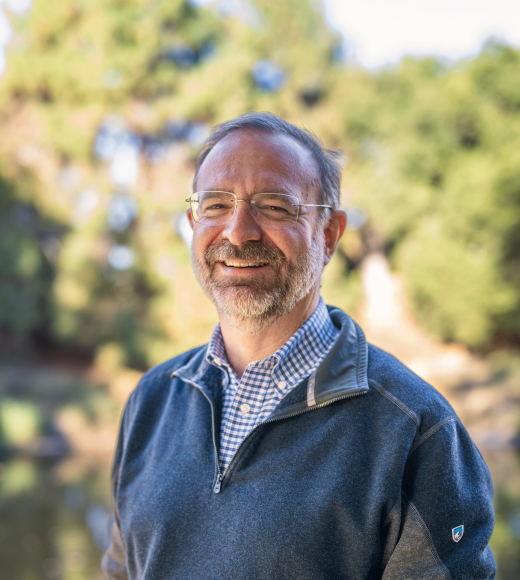UC Davis Bohart Museum of Entomology Welcomes New Director with Spider Expertise
Distinguished Professor Lynn Kimsey Retires After 34 Years as Director

Professor Jason Bond starts today (Feb. 1) as the new director of the UC Davis R.M. Bohart Museum of Entomology, which houses the 7th largest insect collection in North America. Bond succeeds Lynn Kimsey, distinguished professor with the Department of Entomology and Nematology, who retired last month after serving as the museum’s director and curator since 1990.
Since it first opened in 1946, the Bohart Museum has grown from having 200 specimens to nearly eight million. It features diverse collections of mites, moths, spiders, beetles, worms and more. It has one of the world’s largest collections of tardigrades, tiny aquatic animals also known as water bears.
The future of the museum is now in Bond’s hands and he’s ready for the fun adventure ahead.
“It’s really exciting, and right off the bat it’s going to be a lot of fun because of the great shape that the museum is in owing to Lynn’s great work,” Bond said.
Spider specialist
Bond joined UC Davis in 2018 as the Evert and Marion Schlinger Endowed Chair in the Department of Entomology and Nematology. He’s also associate dean of agricultural sciences for the College of Agricultural and Environmental Sciences. Before his time in Davis, Bond was the director of the Auburn University Museum of Natural History from 2011–2016 and was chair of the university’s Department of Biological Sciences from 2016–2018.
From discovering a new species of trap door spider at Moss Landing State Beach in Northern California, to a grueling, weeks-long expedition to find a certain beetle in Namibia near the Angolan border, Bond has been studying the evolutionary diversification and taxonomy of spiders, millipedes and tenebrionid beetles for decades.
Like many students starting out in life sciences, he said he was originally intent on pursuing medical school, until a project on spiders as an undergraduate at Western Carolina University changed his path.

“I started working on spider silk; it’s an incredibly remarkable natural product. I went from working on silk to trap door spider and tarantula systematics and taxonomy, these absolutely beautiful animals use their silk to build remarkable, engineered structures,” he said. “I was sold.”
He brings his love of spiders to the classroom with an arachnology course every fall, in which he teaches about the ecology, evolution and behavior of spiders. The course’s lab component uses the Bohart’s specimens to help train students. The museum supports campus classes with specimens, live insects and exhibits. It also loans approximately 7,000 specimens a year to scientists around the world.
“We know how important those collections of insects and spiders that people collected 50 years ago are to us today, and certainly the same will be true into the future as the planet, climate and our lands continue to change in terms of their use,” Bond said. “Understanding what was there, and how that diversity has changed through time, all that information is contained in museum collections.”
In his new role, Bond said his top priorities include expanding and properly maintaining the specimen collections and continuing with the exemplary outreach efforts in the surrounding communities. He would also like to explore other ways the museum can serve as a resource for insect-based research on the Davis campus and beyond, including having tissues available for genomic and genetic research. His goals for the future also include expanding digital resources by making more specimen images accessible online.

Legacy of bugs
The museum is named in honor of the late Richard Bohart, a member of the UC Davis faculty for more than 50 years. He was its founding director and was succeeded by Kimsey, his former doctoral student.
During her tenure, Kimsey has prioritized making the collections available for the public and to share why insects are so important to us all. The facility has a live “petting zoo” that includes Madagascar hissing cockroaches, stick insects and tarantulas. There’s also a gift shop with unique insect-themed items and apparel. The museum draws an average of 15,000 visitors a year through open houses, off-site programs and lectures.
“I’m proud of the depths and breadth of our outreach programs, otherwise this would just be a collection of dead stuff,” she said. “We have the opportunity to educate so many people. We had two high school groups from Sacramento come visit recently and to hear them get excited about insects was awesome.”
Kimsey will continue to help prepare specimens for display and share her vast insect knowledge with museum guests. She will continue her role as director of the Bohart Museum Society, which includes producing a newsletter filled with stories about insects.
Other retirement plans include working with a team in San Luis Obispo this summer teaching a forensic fire death investigation course, where participants will learn, among other things, the role insects may play at the crime scene. She also plans to travel with her husband, Bob Kimsey, a forensic entomologist at UC Davis who plans to retire at the end of this academic year.
Kimsey got her first butterfly net when she was five years old, igniting a lifelong curiosity for insects. And after all these years, she doesn’t plan to give it up anytime soon.
“I could never in a million years have guessed I would continue running around with a butterfly net collecting bugs for 65 years,” she said. “I don’t see anything changing except I’ll have more time to show people bugs.”
Media Resources
- Jason Bond, Department of Entomology and Nematology, jbond@ucdavis.edu
- Lynn Kimsey, Department of Entomology and Nematology, lskimsey@ucdavis.edu
- Tiffany Dobbyn, College of Agricultural and Environmental Sciences, tadobbyn@ucdavis.edu